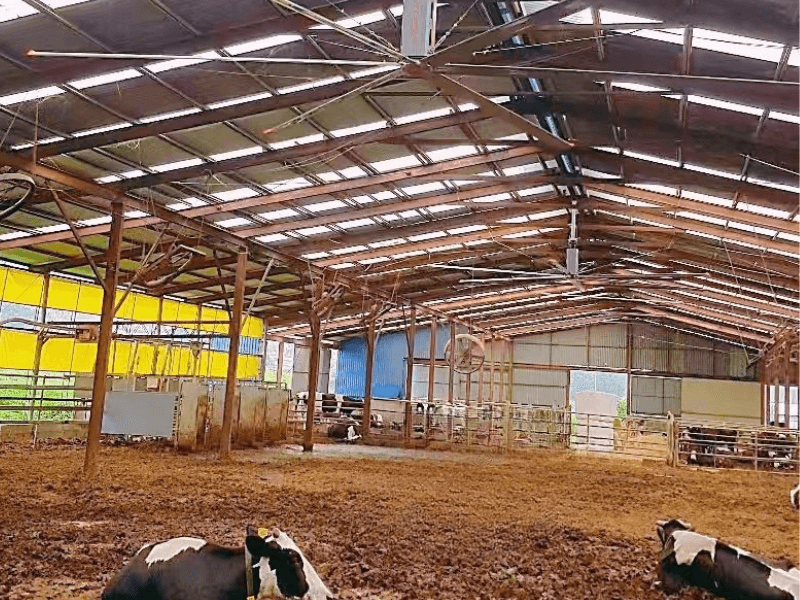The dairy barns are the center of milk production, and due to high humidity, they become home to hoof disease causing farmers millions of dollars of losses. A leading problem in dairy farming, Lameness is a risk to cow welfare and profitability, commonly induced by damp floors and air quality. Industrial ceiling fans, particularly the HVLS make dairy cows less lame as they improve air movement, reduce humidity in the barn as well as the damp floor conditions which contribute to hoof issues. These fans reduce the humidity of barns by 10-15% and provide drier, safer surfaces, which increase the humidity lameness of barn cows, ceiling fans hoof health dairy, and dairy farm ventilation cattle. This is a game-changer to dairy farmers, barn managers, veterinarians and agricultural engineers. RFANS has revolutionized the world of barns with more than 20 years of experience in ventilation solutions. We will discuss the humidity-lameness connection, the inadequacy of traditional ventilation, the benefit of fans, the health exemplification, the economy, a case study, and Frequently Asked Questions.
The Link Between Humidity and Lameness in Dairy Cows
Lameness in dairy cows is an annual event with 20-35 percent of dairy cows becoming lame with an annual cost of lost dairy output; veterinary costs of about $100 to $300 per animal health studies. The most important culprit is humidity, which provides an environment that is damaging to hoof health.
Excess Moisture Softens Hooves and Promotes Bacterial Growth
Cow respiration and manure maintain a high humidity (>60%) and keep floors wet and soften hooves, predisposing them to infection such as digital dermatitis (hoof rot) and sole ulcers. Wet conditions have been found to grow bacteria by 20-30 percent and lameness risk by 15 percent.

Wet, Slippery Floors Increase Injury and Infections
Barns have damp floors that cause slips and falls that result in injuries to the hooves. Wet flooring has been shown to increase lameness occurrence 2fold with 10-20% associated with the incidence of slips. Bacteria will also flourish in such conditions, worsening infections.
Lameness as a Major Economic Loss
Lameness decreases milk production by 5-15 percent (300-1,000 pounds per lactation) and increases the culling rates by 10 percent. In the case of a 100 cow herd, this translates to 10,000-30,000 annual losses and hence the humidity of these barns and its impact on lameness is an area of great concern.
Why Traditional Ventilation Is Not Enough
Conventional means are not effective in combating humidity in barns.
Inconsistent Natural Airflow
Open-sided barns count on natural ventilation, although wind currents cannot be depended upon, particularly in damp weather. This does not dry floors or dissipate moisture and leaves barns susceptible.
Exhaust-Only Systems Don’t Reduce Floor Moisture
Exhaust fans do not circulate air evenly across its area and only take away a part of it, leaving moist areas around pens. They also use 5-10 kW that does not address the humidity problems and adds costs.
Humidity Buildup in Poorly Ventilated Barns
In high ceiling barns (20-40 feet) without regular air movement, moisture and gases become trapped and impede vapor removal. This brings about an environment where bacteria multiply, compromising reduce lameness dairy barns.

How Ceiling Fans Address Humidity-Related Risks
The HVLS ceiling fans have 8-24 foot diameters and move up to 400,000 cubic feet per minute at low performance (50-100 RPM) to provide specific humidity control of airflow in the barn.
Continuous Airflow Evaporates Floor Moisture
HVLS fans encourage evaporation and get the floor wetness by 10-15%. This dehumidifies, reducing slipping by a fifth and inhibiting bacterial growth, according to agricultural ventilation research.
Prevents Damp, Stagnant Zones Where Bacteria Thrive
Users remove dead air pockets dispersing moisture and ammonia by 15-20%. This is in conformity with ASABE livestock ventilation (0.1- 0.2 CFM per pound animal).
Creates a Drier, Safer Walking Surface
Fans keep the surface safe to walk on by keeping the humidity rate below 60 percent, resulting in a decrease in lameness by 10-15 percent. This promotes cow comfort hoof prevention.
Health and Productivity Benefits
HVLS fans have direct health and production impacts on cows.

Reduced Lameness Cases Lower Veterinary Costs
Fans reduced lameness cases by 10-20% and saved 2000-5000 per 100 cows per year in vet bills by controlling humidity. This decreases the use of antibiotics and treatments.
Comfortable Walking Improves Feed Intake
Cows that have healthy hooves have a much easier walk, and their feed intake is improved by 5-10 per cent. This increases weight gain and milk output which costs a 100-cow herd between $10, 000 and 20,000 annually.
Healthier, Stress-Free Cows Boost Milk Yields
Less stress through improved air quality also increases the yield of milk 5-15% (300-1,000 pounds per lactation), according to dairy research, which increases the earnings of the farm.
Case Example: A Dairy Farm’s Success
High humidity and wet floors in a 150 cow dairy farm in Wisconsin caused 25% lameness and cost the farm $20,000 a year in lost milk and veterinary expenses. HVLS ventilation systems in dairy cattle, with three 18-foot fans, helped reduce humidity (12 percent) and lameness (15 percent). The result has been an increase in milk yield (10 percent or 15,000/year), reduction in vetting expenditures (3,000 each year) and saving on energy (2,500/year). Odor complaints to neighbors also decreased, indicating ceiling fans prevent cow hoof disease.
Cost and ROI Aspect
HVLS fans are economically attractive. A 20,000-square-foot barn costs between $20,000 and $40,000 (2-4 fans) to install. Energy savings amount to $2,000-5000, milk yield savings amount to 10,000-20,000, and savings on veter costs amount to 2,000-5,000 annually. ROI is achieved in 6-24 months. Avoiding lameness will save $100-300 per cow, compared to fan expenses. The lifespan of fans 15-20 years guarantees the savings.
FAQ: Common Questions About Ceiling Fans in Barns
- Does airflow really reduce barn humidity?
Yes, HVLS fans reduce humidity by 10-15% by evaporation, decreasing the risk of lameness, according to studies of the airflow humidity of barns. - Can ceiling fans replace floor scraping or bedding management?
No, however they supplement these with drying floors, which minimize bacterial growth to minimize lameness dairy barns. - Are HVLS fans safe around cows?
Yes, they are not dangerous, UL/ETL approved and ceiling mounted, which are helpful in the health of the calf ceilings. - How do fans prevent hoof disease?
Fans prevent cow hoof disease by reducing moisture and bacteria by approximately 10-20 percent and improving the air quality of the stables.
Conclusion
Barns are known to cause lameness due to high humidity which costs farmers thousands of dollars but airflow can alter this. HVLS fans lower moisture buildup, enhance hoof health, and increase productivity providing solutions to lameness in barn humidity. Commercial ceiling fans are recommended by dairy farmers as a component of an integrated barn management approach to enhance better hoof health, animal welfare and the profitability of a farm. RTFANS is a company that has 20+ years of experience providing customized HVLS solutions. Today contact us to improve the air quality in your barn, your cows and profits need it.
